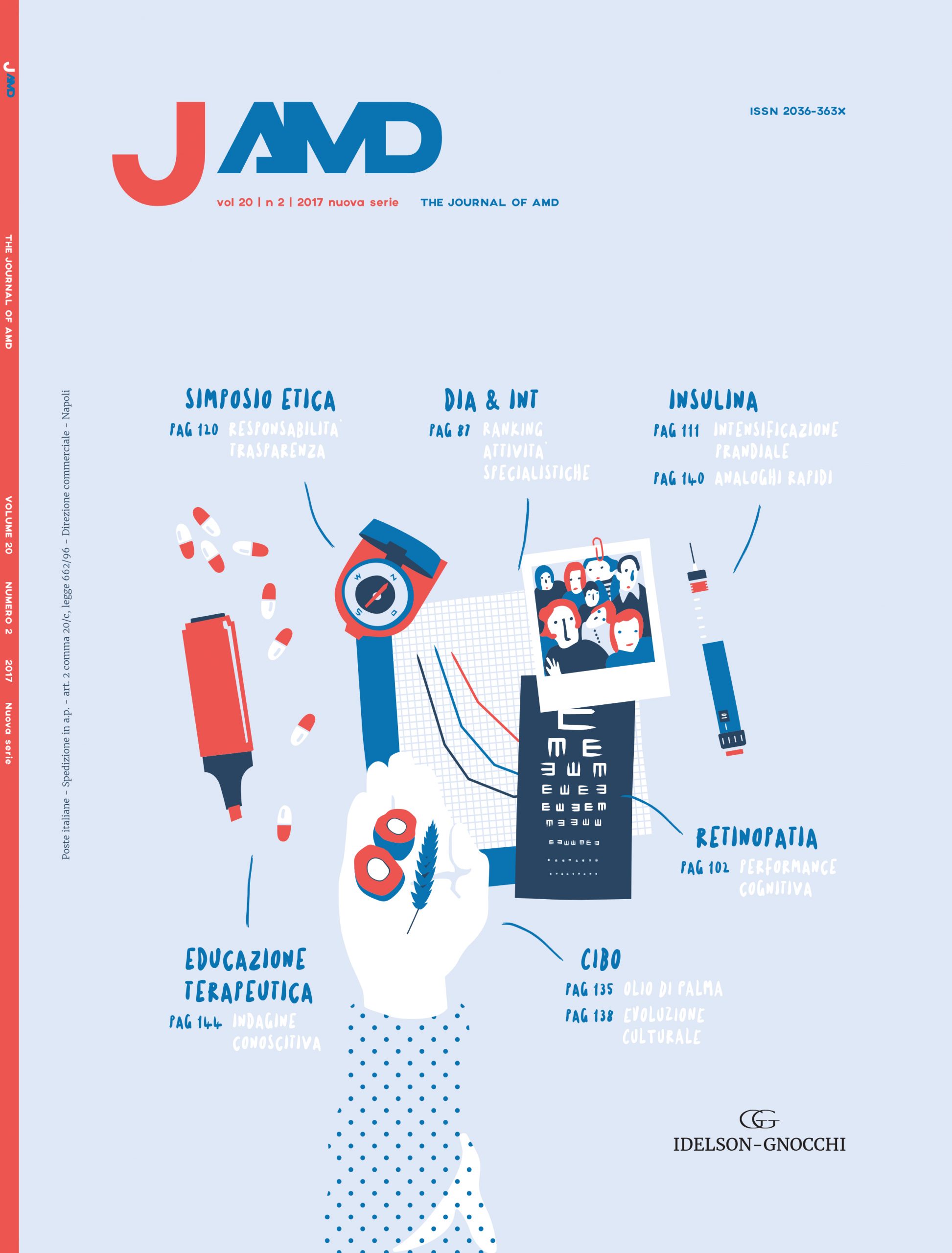Editorial
The present is already in the future!
JAMD 2017;20(2):84-85
Original articles
AMD (Associazione Medici Diabetologi) Diabetes Intelligence project as a tool for a practical Chronic Care Model implementation: evaluation and ranking of diabetologist specialty activities following the SROI method (Social Return Of Investment)
JAMD 2017;20(2):87-101
Improved cognition in severe Tudiabetic retinopathy
JAMD 2017;20(2):102-110
OBJECTIVES Over the last few decades, a correlation between both diabetes and diabetic retinopathy with cognitive impairment has been established. Two UK-based studies have examined whether diabetic retinopathy and cognitive decline worsen at the same rate, and the experiments had opposite results. The current study therefore proposed a new insight on the subject in an Italian population.
Research design and methods Seventy-seven diabetic patients were recruited from their local hospital and grouped by severity of retinopathy. The groups were: no retinopathy (control group, n=15), mild / moderate (n=30), pre-proliferative / proliferative (n=32). Each participant underwent a cognitive assessment through some subtests of the Italian version of the Wechsler Adult Intelligence Scale (WAIS). The areas of cognition tested were visuospatial ability, linguistic ability and working memory. Pearson’s correlation in SPSS Statistics was used to assess the relationship between retinopathy and cognitive performance, adjusting for confounders.
RESULTS Severity of retinopathy demonstrated an inverse relationship with cognitive performance in visuospatial (TestMW=10,3883 p<0.01) and linguistic (Ftest=13,368 p<0.000) skills. No correlation resulted between degree of retinopathy and working memory.
CONCLUSIONS Participants with advanced retinopathy performed better than patients with no or mild retinopathy. This further confirms one of the two previous results on the subject, and leads to new hypotheses over glucose-related damage and absorption in different organs (here, retina and brain).
KEYWORDS Diabetes mellitus, Diabetic retinopathy, Cognition, Cognitive Impairment, Visuospatial ability, Linguistic ability.
Esperienze di diabetologia clinica
Strategies for prandial intensification of insulin therapy: the SPRINT project
JAMD 2017;20(2):111-119
The intensification of prandial insulin therapy aims to get an “adequate” and – as much as possible – “physiological” glycemic profile in patients with poorly controlled diabetes. The SPRINT (Strategies for PRandial INTensification) project intended to portray the clinical practice and to gather the opinions of Italian specialists involved in the management of patients with type 2 diabetes mellitus on some topics of interest in the rapidly evolving therapeutic landscape for this disease.
The project dealt with issues like the use of technology (electronic medical record and tools for self-monitoring of blood glucose) and phenotyping indices useful to steer the therapeutic choice towards a strategy of prandial intensification with GLP-1 RA or with basal bolus/basal plus insulin, in view of a personalization of therapy.
About 300 experts from all over the Country have been involved, most of them diabetologists, and they have taken part in two series of structured meetings (each round composed of 28 meetings held in 17 regions) and in an online survey. Data collected and opinions emerged from the discussions indicate that the electronic medical record is now widespread: 71,3% of participants already use it regularly, and in almost all cases it is MyStar Connect. In regards to glycemic self-monitoring, the need to use technologically advanced instruments grows with the increasing degree of intensification of therapy. However, in the experience of over half of participants, at least one of two patients does not self-monitor accurately, and the most common revision support is still a paper-based logbook.
Finally, there was a high level of agreement among participants about significant phenotyping indices to orient the choice between the two prandial intensification strategies analyzed. All that has led to the definition of a new dedicated feature that could be implemented in the MyStar Connect.
KEYWORDS Type 2 diabetes mellitus, Prandial intensification, GLP-1 RA, Basal bolus insulin therapy.
Simposio
Ethics in the profession and organizations. Let’s talk about it
JAMD 2017;20(2):120-122
Ethics as a tool to promote accountability in organizations
JAMD 2017;20(2):123-128
Slow Medicine: aligning the principles of ethics to professional practice
JAMD 2017;20(2):129-132
Integrity and transparency in healthcare system
JAMD 2017;20(2):133-134
Punto di vista
The question of palm oil: yes or not
JAMD 2017;20(2):135-137
Commentary
Food, health, policy… and evolution of human been culture
JAMD 2017;20(2):138-139
Consensus document
Rapid insulin analogues. Technical note
JAMD 2017;20(2):140-143
Surveys
Diabetes Education in Italy: un updated GISED Survey
JAMD 2017;20(2):144-154
The Italian Group for the Study of Diabetes Education (GISED) promoted an update (2014-15) on the status of Therapeutic Education (ET) in Italy, aiming at evaluating how ET is performed and its changes compared to the previous survey (2004). A 41 item questionaire was sent to 803 national diabetologic centers, 463 answers were received; 79% of the centers perform ET (vs. 94% in 2004); 77.4% adopt the computerized record and 29.5% use telemedicine. Compared to 2004, most parameters grew: ET documentation (71 vs 63%), professional training (83 vs. 21.5%), team collaboration (51.5 vs. 38.5%), dedicated spaces (74 vs. 68%), financing (44 vs 16%). ET is performed during outpatient visit (71.7 vs 83.5 %), specific sessions (72.3 vs 47.5%), residential courses (18.6 vs. 8.7%). It is structured in 50.4 % of Individual Intervention (II) and 30.7 % of Group Intervention (GI) (vs 20.7 and 39.6 %) with increased use of problem solving (69.5 vs 19.3 % for II, 54.2 vs 27.6 % for GI). The tools used are mainly paper (95 % II, 66 % GI) and computerized (62 % II, 56 % GI); limited use of digital media on mobile devices (7 % II, 11 % GI). The assessment of II and GI is performed in 54 % and 58 % (vs 58 and 60 %). Periodic revaluation of educational interventions are made in 53% of cases (vs. 51%). The lower percentage of centers performing ET in Italy in 2014 is compared to the smallest number of responses received in 2004 (212 centers, maybe the most active in ET). Despite some improvements, ET structuration, evaluation, its financing and the use of innovative tools needs implementation.
KEYWORDS Diabete mellitus, Therapeutic education, Educational tools, Educational interventions.
Le news di AMD
Newsletter Annali AMD n. 19
JAMD 2017;20(2):155-156
Newsletter AMD n. 35
JAMD 2017;20(2):157
Gruppo Medicina di Genere
JAMD 2017;20(2):158




